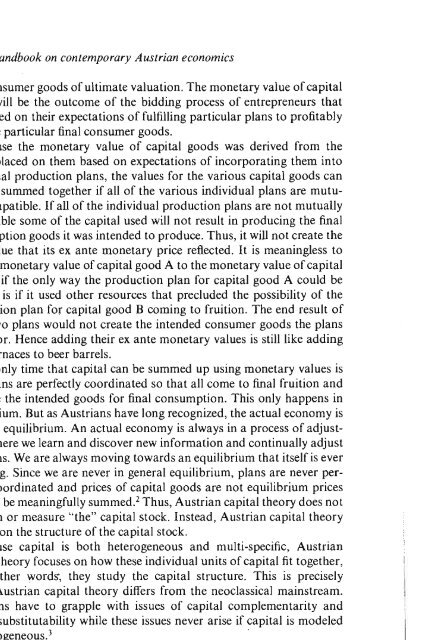Handbook on Contemporary Austrian Economics
Handbook on Contemporary Austrian Economics
Handbook on Contemporary Austrian Economics
You also want an ePaper? Increase the reach of your titles
YUMPU automatically turns print PDFs into web optimized ePapers that Google loves.
126 <str<strong>on</strong>g>Handbook</str<strong>on</strong>g> <strong>on</strong> c<strong>on</strong>temporary <strong>Austrian</strong> ec<strong>on</strong>omics<br />
final c<strong>on</strong>sumer goods of ultimate valuati<strong>on</strong>. The m<strong>on</strong>etary value of capital<br />
goods will be the outcome of the bidding process of entrepreneurs that<br />
was based <strong>on</strong> their expectati<strong>on</strong>s of fulfilling particular plans to profitably<br />
produce particular final c<strong>on</strong>sumer goods.<br />
Because the m<strong>on</strong>etary value of capital goods was derived from the<br />
values placed <strong>on</strong> them based <strong>on</strong> expectati<strong>on</strong>s of incorporating them into<br />
individual producti<strong>on</strong> plans, the values for the various capital goods can<br />
<strong>on</strong>ly be summed together if all of the various individual plans are mutually<br />
compatible. If all of the individual producti<strong>on</strong> plans are not mutually<br />
compatible some of the capital used will not result in producing the final<br />
c<strong>on</strong>sumpti<strong>on</strong> goods it was intended to produce. Thus, it will not create the<br />
final value that its ex ante m<strong>on</strong>etary price reflected. It is meaningless to<br />
add the m<strong>on</strong>etary value of capital good A to the m<strong>on</strong>etary value of capital<br />
good B if the <strong>on</strong>ly way the producti<strong>on</strong> plan for capital good A could be<br />
fulfilled is if it used other resources that precluded the possibility of the<br />
producti<strong>on</strong> plan for capital good B coming to fruiti<strong>on</strong>. The end result of<br />
these two plans would not create the intended c<strong>on</strong>sumer goods the plans<br />
called for. Hence adding their ex ante m<strong>on</strong>etary values is still like adding<br />
blast furnaces to beer barrels.<br />
The <strong>on</strong>ly time that capital can be summed up using m<strong>on</strong>etary values is<br />
if all plans are perfectly coordinated so that all come to final fruiti<strong>on</strong> and<br />
produce the intended goods for final c<strong>on</strong>sumpti<strong>on</strong>. This <strong>on</strong>ly happens in<br />
equilibrium. But as <strong>Austrian</strong>s have l<strong>on</strong>g recognized, the actual ec<strong>on</strong>omy is<br />
never in equilibrium. An actual ec<strong>on</strong>omy is always in a process of adjustment<br />
where we learn and discover new informati<strong>on</strong> and c<strong>on</strong>tinually adjust<br />
our plans. We are always moving towards an equilibrium that itself is ever<br />
changing. Since we are never in general equilibrium, plans are never perfectly<br />
coordinated and prices of capital goods are not equilibrium prices<br />
that can be meaningfully summed. 2 Thus, <strong>Austrian</strong> capital theory does not<br />
focus <strong>on</strong> or measure "the" capital stock. Instead, <strong>Austrian</strong> capital theory<br />
focuses <strong>on</strong> the structure of the capital stock.<br />
Because capital is both heterogeneous and multi-specific, <strong>Austrian</strong><br />
capital theory focuses <strong>on</strong> how these individual units of capital fit together,<br />
or in other wordS', they study the capital structure. This is precisely<br />
where <strong>Austrian</strong> capital theory differs from the neoclassical mainstream.<br />
<strong>Austrian</strong>s have to grapple with issues of capital complementarity and<br />
capital substitutability while these issues never arise if capital is modeled<br />
as homogeneous. 3 .<br />
Capital complementarity stems from the fact that it most often requires<br />
more than a single capital good to produce the final c<strong>on</strong>sumpti<strong>on</strong> good.<br />
Few cars will be produced if <strong>on</strong>ly the physical building for the assembly<br />
line is c<strong>on</strong>structed but the individual assembly machines are not included

















